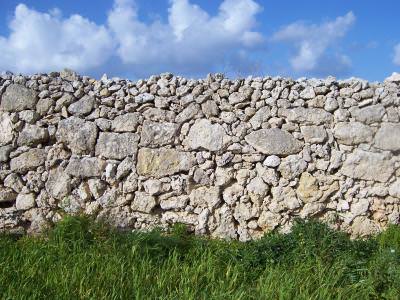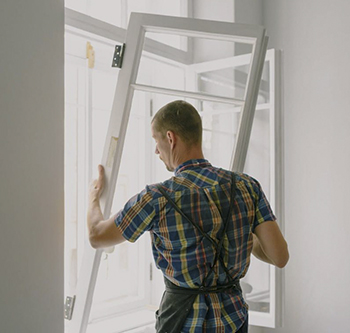Rubble masonry
Rubble masonry, also known as rubblework, is the use of undressed, rough stone, generally for the construction of walls.
The most basic form of rubble masonry is dry-stone rubble walls which are very common in rural locations and popular with landscapers looking for a traditional aesthetic. The rough, unhewn stones are piled on top of one another without mortar, and are often laid in irregular horizontal courses.
Alternatively, the stones can be bound with cement or lime mortar, although in this case, a greater degree of stone selection may be required to avoid excessively wide mortar joints. Stones can be bonded by laying longer ones both along the face and oriented lengthwise across the depth of the wall. Selected stones are laid to form roughly square angles at quoins and around openings.
Polygonal rubble walling is where stones are split-faced and roughly dressed to suit a specific pattern or design. Random rubble walls involve stones of varying sizes and joint widths with small wedge-shaped fillets bedded into the mortar between them.
Rubble masonry can also be used as the outer surface of a wall, particularly common in medieval cathedrals and historic buildings, and as a core infill between external and internal wall faces.
[edit] Related articles on Designing Buildings Wiki
Featured articles and news
Skills gap and investment returns on apprenticeships
ECA welcomes new reports from JTL Training and The Electrotechnical Skills Partnership.
Committee report criticises UK retrofit schemes
CIOB responds to UK’s Energy Security and Net Zero Committee report.
Design and construction industry podcasts
Professional development, practice, the pandemic, platforms and podcasts. Have we missed anything?
C20 Society; Buildings at Risk List 2025
10 more buildings published with updates on the past decade of buildings featured.
Boiler Upgrade Scheme and certifications consultation
Summary of government consultation, closing 11 June 2025.
Deputy editor of AT, Tim Fraser, discusses the newly formed society with its current chair, Chris Halligan MCIAT.
Barratt Lo-E passivhaus standard homes planned enmasse
With an initial 728 Lo-E homes across two sites and many more planned for the future.
Government urged to uphold Warm Homes commitment
ECA and industry bodies write to Government concerning its 13.2 billion Warm Homes manifesto commitment.
From project managers to rising stars, sustainability pioneers and more.
Places of Worship in Britain and Ireland, 1929-1990. Book review.
The emancipation of women in art.
Call for independent National Grenfell oversight mechanism
MHCLG share findings of Building Safety Inquiry in letter to Secretary of State and Minister for Building Safety.
The Architectural Technology Awards
AT Awards now open for this the sixth decade of CIAT.
50th Golden anniversary ECA Edmundson awards
Deadline for submissions Friday 30 May 2025.
The benefits of precast, off-site foundation systems
Top ten benefits of this notable innovation.
Encouraging individuals to take action saving water at home, work, and in their communities.
Takes a community to support mental health and wellbeing
The why of becoming a Mental Health Instructor explained.
























